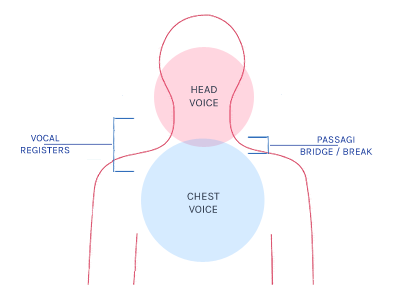What Are The Different Types Of Singing Voices?
As a vocal coach, students and singers alike always ask me:
"How many notes can I sing?" or "What is the range of my voice?"
What they are actually asking is: "What is my Voice Type?"
What is a Voice Type?
A voice type is a group of voices with close vocal ranges, capable of singing in a similar tessitura, and have similar passaggio.
To make it simpler, a voice type gathers voices that can reach the same notes (highs and lows) and have the same comfortable singing zone and vocal transition points.
So, voices who can sing the same notes and sound almost similar will be categorized in the same voice type!
How many Voice Types exist?
There are 6 common voice types:
3 Male Voice Types
- Bass the lowest singing range
- Baritone the second lowest singing range
- Tenor the highest singing range of male voices
- Alto the lowest singing range of female voices
- Mezzo Soprano the middle-range of female voices - it overlaps both alto & soprano ranges
- Soprano the highest singing range
Professional singers, especially opera singers, are placed into a category depending on different factors in their voices.
If you're wondering about those factors, here's a quick list:
1. Range: Figuring out your vocal range means defining which notes you can actually hit without struggling or straining your voice.
2. Tessitura: Regardless of how strong the
notes at each end of your range are, those are surely not the most comfortable
notes to sing for you.
Somewhere around the
middle of your range, you’ll find the notes that you feel most comfortable
singing. That is your tessitura
3. Transitions: Have you ever noticed
that you have to adjust your voice in order to hit higher notes?
This zone is called
the transition spot. It’s
where you switch from your chest register to your head register (your lower
fuller voice to high notes).
4. Vocal Register: It is determined by measuring both the chest (lowest to highest note of your chest voice) and head (lowest to highest note of your head voice) registers.
5. Weight: It’s the lightness or
heaviness of your voice.
One singer might have a
deep, rich voice, while another one, in the same range, can have a lighter,
brighter voice.
Think of a Violin and a
Cello for instance, they can play few similar notes but, when played simultaneously, you can hear a difference in their sound because they are of
different sizes.
6. Physical Characteristics: Your Body Weight, Age and Size of your Larynx...
Vocal maturity is usually reached in late or after puberty, Most of the time, women reach it earlier than men (women at around 18 and men around 21). Did you notice how pre-puberty, your speaking voice sounds different than after puberty? It's lighter, brighter and higher pitched and becomes deeper and lower pitched the more you grow. This is due to your body and larynx getting bigger in size.
A child's body is short and small and so are his vocal cords! So, if you're speaking voice changes when you grow up then surely your singing voice will change too, affecting your vocal type!
Vocal Type Ranges:
Talking about the range of a voice type is not only mentioning the group of notes it can reach, it's mentioning also the passaggio and tessitura.
The more you practice and develop your technique, the wider your range will become improving the quality of your voice; so, don't let the range classification bring you down, keep working and expanding your voice!
- Bass
- Its typical range is from E2 to E4 (some basses can sing from C2 up to G4)
- Its comfortable range is from B2 to B3
- Its passaggio ranges from Ab3 to Db4
- Baritone
- Its typical range is from A2 to A4 (some can extend from F2 up to C5)
- Its comfortable range is from C3 to E4
- Its passaggio ranges from B3 to E4
- Tenor
- Its typical range is from C3 to C5
- Its comfortable range is from F3 to F4
- Its passaggio ranges from D4 to G4
- Contralto / Alto
- Its typical range is from F3 to F5
- Its comfortable range is from Eb4 to Eb5
- Its passaggio ranges from B4 to Eb5
- Mezzo-Soprano
- Its typical range is from A3 to A5
- Its comfortable range is from F4 to F5
- Its passaggio ranges from C4 to F5
- Soprano
- Its typical range is from C4 to C6
- Its comfortable range is from G4 to G5
- Its passaggio ranges from Db5 to Gb5
It is important to mention that those classifications are mostly important for classical voices. In fact, it is somewhat irrelevant for modern singers as they can sing any song by transposing the music; so, when it comes to choosing a song, comfort is key!
Finding out your voice type is a process that usually takes time as it demands knowing your instrument and your capabilities. It took me several months to figure out what my voice type was!
Regardless of what your vocal type might be, you can always work on your voice to maximize your vocal abilities. The best and quickest way to do so is by taking regular weekly singing lessons with a qualified voice teacher!
So, do you know where your voice fits?









Comments
Post a Comment